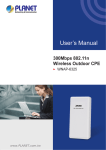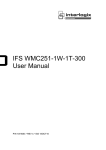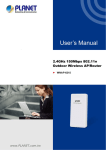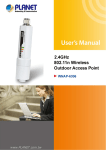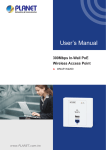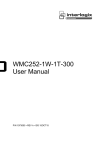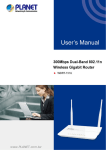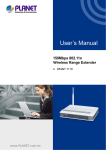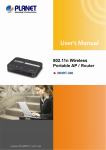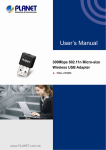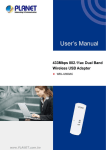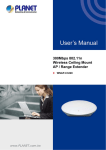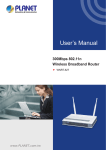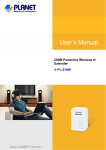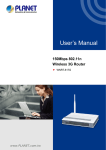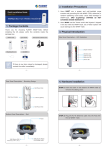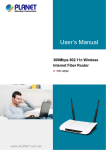Download User`s Manual - PLANET Technology Corporation.
Transcript
Copyright
Copyright 2015 by PLANET Technology Corp. All rights reserved. No part of this publication may
be reproduced, transmitted, transcribed, stored in a retrieval system, or translated into any language
or computer language, in any form or by any means, electronic, mechanical, magnetic, optical,
chemical, manual or otherwise, without the prior written permission of PLANET.
PLANET makes no representations or warranties, either expressed or implied, with respect to the
contents hereof and specifically disclaims any warranties, merchantability or fitness for any particular
purpose. Any software described in this manual is sold or licensed "as is". Should the programs
prove defective following their purchase, the buyer (and not this company, its distributor, or its dealer)
assumes the entire cost of all necessary servicing, repair, and any incidental or consequential
damages resulting from any defect in the software. Further, this company reserves the right to revise
this publication and to make changes from time to time in the contents hereof without obligation to
notify any person of such revision or changes.
All brand and product names mentioned in this manual are trademarks and/or registered trademarks
of their respective holders.
Federal Communication Commission Interference Statement
This equipment has been tested and found to comply with the limits for a Class B digital device,
pursuant to part 15 of the FCC Rules. These limits are designed to provide reasonable
protection against harmful interference when the equipment is operated in a commercial
environment. This equipment generates, uses, and can radiate radio frequency energy and, if not
installed and used in accordance with the instruction manual, may cause harmful interference to
radio communications. Operation of this equipment in a residential area is likely to cause harmful
interference in which case the user will be required to correct the interference at his/her own
expense. Any changes or modifications not expressly approved by PLANET could void the user’s
authority to operate this equipment under the rules and regulations of the FCC.
FCC Caution:
To assure continued compliance, (for example, use only shielded interface cables when connecting
to computer or peripheral devices) any changes or modifications not expressly approved by the party
responsible for compliance could void the user’s authority to operate the equipment.
This device complies with Part 15 of the FCC Rules. Operation is subject to the following two
conditions:
(1) This device may not cause harmful interference
(2) This device must accept any interference received, including interference that may cause
undesired operation.
Federal Communication Commission (FCC) Radiation Exposure Statement
This equipment complies with FCC radiation exposure set forth for an uncontrolled environment. In
order to avoid the possibility of exceeding the FCC radio frequency exposure limits, human proximity
to the antenna shall not be less than 20 cm (8 inches) during normal operation.
I
CE Mark Warning
This is a Class B product. In a domestic environment, this product may cause radio interference, in
which case the user may be required to take adequate measures.
Energy Saving Note of the Device
This power required device does not support Standby mode operation. For energy saving, please
remove the DC-plug to disconnect the device from the power circuit. Without removing the DC-plug,
the device still consumes power from the power circuit. In view of Saving the Energy, it is strongly
suggested to remove the DC-plug for the device if this device is not intended to be active.
R&TTE Compliance Statement
This equipment complies with all the requirements of DIRECTIVE 1999/5/CE OF THE EUROPEAN
PARLIAMENT AND THE COUNCIL OF 9 March 1999 on radio equipment and telecommunication
terminal Equipment and the mutual recognition of their conformity (R&TTE). The R&TTE Directive
repeals and replaces in the directive 98/13/EEC (Telecommunications Terminal Equipment and
Satellite Earth Station Equipment) as of April 8, 2000.
Safety
This equipment is designed with the utmost care for the safety of those who install and use it.
However, special attention must be paid to the dangers of electric shock and static electricity when
working with electrical equipment. All guidelines of this and of the computer manufacture must
therefore be allowed at all times to ensure the safe use of the equipment.
WEEE regulation
To avoid the potential effects on the environment and human health as a result of the
presence of hazardous substances in electrical and electronic equipment, end users of
electrical and electronic equipment should understand the meaning of the crossed-out
wheeled bin symbol. Do not dispose of WEEE as unsorted municipal waste and thus,
WEEE has to be collected separately.
II
Revision
User’s Manual of PLANET 300Mbps 802.11n Outdoor Wireless CPE
Model: WNAP-6325 / WNAP-6335
Rev: 1.0 (May, 2015)
Part No. EM-WNAP-6325_v1.0 (2081-E10590-000) / EM-WNAP-6335_v1.0 (2081-E10600-000)
III
CONTENTS
Chapter 1.Product Introduction........................................................................................................... 8
1.1
Package Contents ............................................................................................................... 8
1.2
Product Description............................................................................................................ 9
1.3
Product Features...............................................................................................................10
1.4
Product Specifications ..................................................................................................... 11
Chapter 2.Hardware Installation ........................................................................................................13
2.1
Hardware Description .......................................................................................................13
2.1.1
The Bottom Panel – Port ........................................................................................14
Chapter 3.Connecting to the AP ........................................................................................................17
3.1
Preparation before Installation ........................................................................................17
3.1.1
Professional Installation Required ..........................................................................17
3.1.2
Safety Precautions..................................................................................................17
3.2
Installation Precautions....................................................................................................17
3.3
Installing the AP ................................................................................................................19
Chapter 4.Quick Installation Guide ...................................................................................................22
4.1
Manual Network Setup - TCP/IP Configuration ..............................................................22
4.1.1
4.2
Configuring the IP Address Manually .....................................................................22
Starting Setup in the Web UI ............................................................................................25
Chapter 5.Configuring the AP............................................................................................................28
5.1
Operation Mode.................................................................................................................28
5.1.1
Access Point ...........................................................................................................29
5.1.2
Client.......................................................................................................................31
5.1.3
WDS AP ..................................................................................................................33
5.1.4
WDS Client .............................................................................................................34
5.1.5
AP Router ...............................................................................................................35
5.1.6
Wireless ISP ...........................................................................................................36
5.1.7
Security Setting.......................................................................................................37
5.1.8
Advanced Settings..................................................................................................42
5.1.9
Access Control........................................................................................................45
5.1.10 WAN Port Settings ..................................................................................................46
5.1.11 Dynamic DNS Settings ...........................................................................................48
5.1.12 Remote Management .............................................................................................52
5.1.13 DHCP Server Settings ............................................................................................53
5.1.14 DMZ Settings ..........................................................................................................53
5.1.15 Virtual Server Settings ............................................................................................54
5.1.16 IP Filtering Settings.................................................................................................54
5.1.17 Port Filtering Settings .............................................................................................55
5.1.18 MAC Filtering Settings ............................................................................................56
IV
5.1.19 Bandwidth Control ..................................................................................................56
5.1.20 SNMP......................................................................................................................57
5.2
System Configuration.......................................................................................................58
5.2.1
Default IP Settings ..................................................................................................58
5.2.2
Time Settings ..........................................................................................................59
5.2.3
Password Settings ..................................................................................................60
5.2.4
System Management..............................................................................................61
5.2.5
Ping Watchdog........................................................................................................62
5.2.6
Firmware Upgrade ..................................................................................................62
5.2.7
Configuration Save and Restore ............................................................................63
5.2.8
Factory Default .......................................................................................................63
5.2.9
Reboot System .......................................................................................................64
5.2.10 Schedule Reboot ....................................................................................................64
5.3
5.4
5.5
Tools ...................................................................................................................................66
5.3.1
Network Ping ..........................................................................................................66
5.3.2
Network Traceroute ................................................................................................66
Device Status.....................................................................................................................68
5.4.1
Device Information..................................................................................................69
5.4.2
Wireless Information ...............................................................................................70
5.4.3
LAN Information......................................................................................................71
5.4.4
Wireless Client Table ..............................................................................................72
5.4.5
System Log.............................................................................................................73
Logout ................................................................................................................................73
Appendix A: Troubleshooting............................................................................................................75
Appendix B: Use Planet Smart Discovery to find AP ......................................................................77
Appendix C: FAQ.................................................................................................................................78
Q1: How to set up the AP Client Connection...........................................................................78
Q2: How to set up the WDS Connection ..................................................................................86
V
FIGURES
FIGURE 2-1 THREE-WAY VIEW .............................................................................................................................. 13
FIGURE 2-2 LED................................................................................................................................................... 14
FIGURE 2-3 WNAP-6325 BOTTOM PANEL............................................................................................................ 15
FIGURE 2-4 WNAP-6335 BOTTOM PANEL............................................................................................................ 15
FIGURE 2-5 POE INJECTOR ................................................................................................................................... 15
FIGURE 3-1 CONNECT THE ANTENNA ................................................................................................................... 19
FIGURE 3-2 WNAP-6325 CONNECT THE ETHERNET CABLE ................................................................................. 19
FIGURE 3-3 WNAP-6335 CONNECT THE ETHERNET CABLE ................................................................................. 19
FIGURE 3-4 WNAP-6325 CONNECT THE POE INJECTOR ....................................................................................... 20
FIGURE 3-5 WNAP-6335 CONNECT THE POE INJECTOR ....................................................................................... 20
FIGURE 3-6 WNAP-6325 POLE MOUNTING ......................................................................................................... 21
FIGURE 3-7 WNAP-6335 POLE MOUNTING ......................................................................................................... 21
FIGURE 4-1 TCP/IP SETTING ................................................................................................................................ 23
FIGURE 4-2 WINDOWS START MENU .................................................................................................................... 24
FIGURE 4-3 SUCCESSFUL RESULT OF PING COMMAND .......................................................................................... 24
FIGURE 4-4 FAILED RESULT OF PING COMMAND ................................................................................................... 25
FIGURE 4-5 LOGIN BY DEFAULT IP ADDRESS ......................................................................................................... 25
FIGURE 4-6 LOGIN WINDOW ................................................................................................................................ 26
FIGURE 4-7 WEB UI SCREENSHOT ........................................................................................................................ 26
FIGURE 4-8 CHOOSE OPERATION MODE ............................................................................................................... 27
FIGURE 4-9 CONFIGURE WIRELESS SETTINGS ...................................................................................................... 27
FIGURE 5-1 MAIN MENU ...................................................................................................................................... 28
FIGURE 5-2 OPERATION MODE ............................................................................................................................. 28
FIGURE 5-3 BASIC SETTINGS - AP ........................................................................................................................ 29
FIGURE 5-4 BASIC SETTINGS - CLIENT ................................................................................................................. 31
FIGURE 5-5 BASIC SETTINGS – WDS AP .............................................................................................................. 33
FIGURE 5-6 BASIC SETTINGS – WDS CLIENT ....................................................................................................... 34
FIGURE 5-7 BASIC SETTINGS – AP ROUTER .......................................................................................................... 35
FIGURE 5-8 BASIC SETTINGS – WISP ................................................................................................................... 37
FIGURE 5-9 SECURITY SETTINGS .......................................................................................................................... 37
FIGURE 5-10 SECURITY SETTINGS – WEP ............................................................................................................ 38
FIGURE 5-11 SECURITY SETTINGS – WPA PERSONAL ........................................................................................... 38
FIGURE 5-12 SECURITY SETTINGS – WPA ENTERPRISE ........................................................................................ 39
FIGURE 5-13 SECURITY SETTINGS – WPA2 PERSONAL......................................................................................... 40
FIGURE 5-14 SECURITY SETTINGS – WPA2 ENTERPRISE ...................................................................................... 40
FIGURE 5-15 SECURITY SETTINGS – WPA-MIXED PERSONAL .............................................................................. 41
FIGURE 5-16 SECURITY SETTINGS – WPA-MIXED ENTERPRISE............................................................................ 41
FIGURE 5-17 ADVANCED SETTINGS ...................................................................................................................... 42
FIGURE 5-18 WMM CONFIGURATION .................................................................................................................. 43
FIGURE 5-19 ACCESS CONTROL............................................................................................................................ 45
FIGURE 5-20 WAN PORT SETTINGS – DHCP........................................................................................................ 46
FIGURE 5-21 WAN PORT SETTINGS – STATIC IP ................................................................................................... 46
VI
FIGURE 5-22 WAN PORT SETTINGS – PPPOE ...................................................................................................... 47
FIGURE 5-23 DYNAMIC DNS SETTINGS................................................................................................................ 48
FIGURE 5-24 REMOTE MANAGEMENT .................................................................................................................. 52
FIGURE 5-25 DHCP SERVER SETTINGS ................................................................................................................ 53
FIGURE 5-26 DMZ SETTINGS ............................................................................................................................... 53
FIGURE 5-27 VIRTUAL SERVER SETTINGS ............................................................................................................. 54
FIGURE 5-28 IP FILTERING SETTINGS ................................................................................................................... 55
FIGURE 5-29 PORT FILTERING SETTINGS .............................................................................................................. 55
FIGURE 5-30 MAC FILTERING SETTINGS ............................................................................................................... 56
FIGURE 5-31 BANDWIDTH CONTROL SETTINGS .................................................................................................... 56
FIGURE 5-32 SNMP SETTINGS ............................................................................................................................. 57
FIGURE 5-33 SYSTEM CONFIGURATION DEFAULT PAGE ......................................................................................... 58
FIGURE 5-34 DEFAULT IP SETTINGS ..................................................................................................................... 58
FIGURE 5-35 TIME SETTINGS ................................................................................................................................ 59
FIGURE 5-36 PASSWORD SETTINGS ....................................................................................................................... 60
FIGURE 5-37 SYSTEM MANAGEMENT ................................................................................................................... 61
FIGURE 5-38 PING WATCHDOG ............................................................................................................................. 62
FIGURE 5-39 FIRMWARE UPGRADE ....................................................................................................................... 62
FIGURE 5-40 CONFIGURATION SAVE AND RESTORE .............................................................................................. 63
FIGURE 5-41 FACTORY DEFAULT .......................................................................................................................... 63
FIGURE 5-42 REBOOT SYSTEM ............................................................................................................................. 64
FIGURE 5-43 SCHEDULE REBOOT ......................................................................................................................... 64
FIGURE 5-44 SCHEDULE REBOOT - EXAMPLE ....................................................................................................... 65
FIGURE 5-45 NETWORK PING ............................................................................................................................... 66
FIGURE 5-46 NETWORK TRACEROUTE.................................................................................................................. 67
FIGURE 5-47 DEVICE STATUS ............................................................................................................................... 68
FIGURE 5-48 DEVICE INFORMATION ..................................................................................................................... 69
FIGURE 5-49 WIRELESS INFORMATION ................................................................................................................. 70
FIGURE 5-50 LAN INFORMATION ......................................................................................................................... 71
FIGURE 5-51 WIRELESS CLIENT TABLE ................................................................................................................ 72
FIGURE 5-52 SYSTEM LOG ................................................................................................................................... 73
FIGURE 5-53 LOGOUT ........................................................................................................................................... 73
FIGURE 5-54 RE-LOGIN ........................................................................................................................................ 74
VII
User Manual of WNAP-6325/WNAP-6335
Chapter 1. Product Introduction
1.1 Package Contents
Thank you for choosing PLANET WNAP-6325 series. Before installing the AP, please verify the contents inside
the package box.
WNAP-6325 / WNAP-6335
Quick Installation Guide
PoE Injector & Power Cord
Plastic Strap x 1
If there is any item missing or damaged, please contact the seller
immediately.
-8-
User Manual of WNAP-6325/WNAP-6335
1.2 Product Description
Cost-effective Wireless Solution with Superior Performance
PLANET WNAP-6325 and WNAP-6335 are designed to provide a highly-stable, better performance and
cost-effective wireless solution in outdoor wireless deployment. With the same transmission power, it offers
better significant range and excellent throughput than those of the traditional 802.11g wireless device. Via the
embedded 12dBi dual-polarization (vertical and horizontal) directional antenna or RP-SMA antenna connectors
connected with various high gain antennas, the WNAP-6325 and WNAP-6335 provides good diversity coverage
and better noise immunity effect, thus heightening the performance of a long-distance, outdoor connectivity even
though the environment is flooded with many 2.4GHz wireless equipment.
Designed for Various Requirements
The WNAP-6325 and WNAP-6335 are dedicatedly designed for WISP solution that provides CPE users with
Internet access via the WISP provider in rural areas. Besides, it caters to various wireless communication
connectivities (AP / Client / WDS PtP / WDS PtMP / WISP), thus meeting users’ application requirements.
Advanced Security and Rigorous Authentication
The WNAP-6325 and WNAP-6335 support WEP, WPA / WPA2, WPA-PSK and WPA2-PSK wireless encryptions,
the advanced WPA2-AES mechanism and 802.1X RADIUS authentication, which can effectively prevent
eavesdropping by unauthorized users or bandwidth occupied by unauthenticated wireless access. Furthermore,
any users are granted or denied access to the wireless LAN network based on the ACL (Access Control List)
that the administrator pre-established. In addition, with the multiple-SSIDs feature, you can set up different
wireless networks. The WNAP-6325 and WNAP-6335 can therefore serve as a virtual access point for
segmented networks tailored to any industrial need.
Flexible and Reliable Outdoor Characteristics
The WNAP-6325 and WNAP-6335 are definitely suitable for such applications as IP surveillance, backhaul link
of building to building and backbone of public service. Additionally, the self-healing and schedule reboot
capability keep connection alive all the time. Meeting the IP55 rating for outdoor UV resistant enclosure, the
WNAP-6325 and WNAP-6335 can perform normally under rigorous weather conditions, meaning it can be
installed in any harsh, outdoor environments. With the proprietary Power over Ethernet (PoE) design, the
WNAP-6325 and WNAP-6335 can be easily installed in the areas where power outlets are not available.
Easy Deployment and Management
With user-friendly Web UI and step-by-step setup wizard, the WNAP-6325 and WNAP-6335 are easy to install,
-9-
User Manual of WNAP-6325/WNAP-6335
even for users who never experience in setting up a wireless network. Furthermore, with the Planet Smart
Discovery Utility and SNMP-based management interface, the WNAP-6325 and WNAP-6335 are convenient to
be managed and configured remotely.
1.3 Product Features
Industrial Compliant Wireless LAN and LAN
Compliant with the IEEE 802.11n wireless technology (with data rate of up to 300Mbps)
Backward compatible with 802.11g standard
Equipped with 10/100Mbps RJ45 ports for LAN and WAN; auto MDI/ MDI-X supported
Fixed-network Broadband Router
Supported connection types: Dynamic IP, Static IP, PPPoE
Supports virtual server and DMZ for various networking applications
Supports DHCP server, UPnP and Planet DDNS
RF Interface Characteristics
Built-in 12dBi dual-polarization antenna (WNAP-6325)
Built-in RP-SMA antenna connectors (WNAP-6335)
High output power up to 500mW with multiply-adjustable transmit power control
Outdoor Environmental Characteristics
IP55 enclosure
Passive Power over Ethernet design
Operating temperature: -20~70°C
Multiple Operations and Wireless Modes
Multiple operation modes: Bridge, WISP
Multiple wireless modes: AP, Client CPE (WISP), WDS PtP, WDS PtMP
Supports multiple SSIDs to allow users to access different networks through a single AP
Supports WMM (Wi-Fi multimedia)
Secure Network Connection
Supports software Wi-Fi Protected Setup (WPS)
Advanced security: 64/128-bit WEP, WPA / WPA2, WPA-PSK / WPA2-PSK (TKIP/AES) and
802.1x RADIUS authentication
Supports IP / Protocol-based access control and MAC filtering
Easy Installation and Management
Web-based UI and quick Setup Wizard for easy configuration
Planet Smart Discovery Utility allows administrator to discover and locate each AP
SNMP-based management interface
System status monitoring includes DHCP Client and System Log
-10-
User Manual of WNAP-6325/WNAP-6335
1.4 Product Specifications
Product
WNAP-6325
WNAP-6335
300Mbps 802.11n Outdoor Wireless CPE
Hardware
IEEE802.11b/g/n
Standard Support
IEEE 802.3
IEEE 802.3u
IEEE 802.3x
Chipset
Memory
PoE
Atheros AR9344
64 Mbytes DDR SDRAM
16 Mbytes Flash
Passive PoE
Wireless IEEE802.11b/g/n, 2T2R
Interface
PoE LAN (LAN 1): 1 x 10/100BASE-TX, auto-MDI/MDIX, passive PoE
LAN 2: 1 x 10/100BASE-TX, auto-MDI/MDIX, passive PoE out pass-through
Built-in 12dBi Dual-Polarization
Antenna
Antenna
Built-in RP-SMA antenna connectors
- Vertical: 20 degrees
- Horizontal: 30 degrees
IEEE 802.11b: 1, 2, 5.5, 11Mbps
Data Rate
IEEE 802.11g: up to 54Mbps
IEEE 802.11n (20MHz): up to 150Mbps
IEEE 802.11n (40MHz): up to 300Mbps
Media Access Control
Modulation
Frequency Band
CSMA/CA
Transmission/Emission type: OFDM
Data modulation type: OFDM with BPSK, QPSK, 16-QAM, 64-QAM
2.412GHz ~ 2.484GHz
America/ FCC: 2.414~2.462GHz (11 Channels)
Operating Channel
Europe/ ETSI: 2.412~2.472GHz (13 Channels)
Japan/ TELEC: 2.412~2.484GHz (14 Channels)
IEEE 802.11b: up to 26 ± 1dBm
RF Output Power (dBm) IEEE 802.11g: up to 23 ± 1dBm
IEEE 802.11n: up to 22 ± 1dBm
Receiver Sensitivity
(dBm)
IEEE 802.11b: -94dBm
IEEE 802.11g: -91dBm
IEEE 802.11n: -89dBm
Output Power Control
12~27Bm
Power Consumption
12W
LAN1
Power Requirements
24V DC, 1A/ Passive PoE
Pin 4,5 V DC+
Pin 7,8 V DC-11-
User Manual of WNAP-6325/WNAP-6335
Pin 3 Reset
Environment & Certification
Operating Temperature
-20~70°c
Operating Humidity
10~95% non-condensing
IP Level
IP55
Regulatory
CE, FCC, RoHS
Software
LAN
Built-in DHCP server supporting static IP address distributing
Support 802.1d STP (Spanning Tree)
Static IP
WAN
Dynamic IP
PPPoE
Bridge
Operation Modes
WISP
NAT firewall with SPI (Stateful Packet Inspection)
Firewall
Built-in NAT server supporting Virtual Server, and DMZ
Built-in firewall with Port/ IP address/ MAC/ URL filtering
AP
Client
Wireless Modes
WDS PTP
WDS PTMP
WISP
Channel Width
Wireless Isolation
Encryption Type
20MHz / 40MHz
Enable it to isolate each connected wireless client so that they cannot access
mutually.
64/128-bit WEP, WPA, WPA-PSK, WPA2, WPA2-PSK, 802.1X
Provides wireless LAN ACL (Access Control List) filtering
Wireless Security
Wireless MAC address filtering
Enable/Disable SSID Broadcast
Max. Wireless Clients
25
Max. WDS AP
8
Max. Wired Clients
60
WMM
Supports Wi-Fi multimedia
QoS
Supports Quality of Service for bandwidth control
NTP
Network Time Management
Self Healing
Supports Schedule Reboot
Management
Web UI, DHCP Client, Configuration Backup & Restore, Dynamic DNS, SNMP
Diagnostic Tool
System Log, Ping Watchdog
-12-
User Manual of WNAP-6325/WNAP-6335
Chapter 2. Hardware Installation
Please follow the instructions below to connect the WNAP-6325 and WNAP-6335 to the existing network
devices and your computers.
2.1 Hardware Description
Dimensions: 127 x 63 x 254 mm (W x D x H)
Figure 2-1 Three-way View
-13-
User Manual of WNAP-6325/WNAP-6335
Rear Panel – LED
Figure 2-2 LED
LED Definition
LED
Power
Wireless
LAN 1
LAN 2
State
Meaning
On
System On
Off
System Off
On
Wi-Fi On
Off
Wi-Fi Off
On
Port linked.
Off
No link.
On
Port linked.
Off
No link.
Table 2-1 The LED indication
2.1.1 The Bottom Panel – Port
The Bottom panel provides the physical connectors connected to the power adapter and any other network
device. Figure 2-3 shows the bottom panel of the WNAP-6325 and WNAP-6335.
-14-
User Manual of WNAP-6325/WNAP-6335
Bottom Panel
Figure 2-3 WNAP-6325 Bottom Panel
Figure 2-4 WNAP-6335 Bottom Panel
PoE Injector
Reset Button
Figure 2-5 PoE Injector
-15-
User Manual of WNAP-6325/WNAP-6335
H/W Interface Definition
Object
Description
10/100Mbps RJ45 port , auto MDI/ MDI-X and passive PoE supported
Connect LAN port to the PoE injector to power on the device.
PoE LAN
(Passive PoE)
Pin assignment:
Pin 4, 5 (+)
Pin 7, 8 (-)
Pin 3 (Reset)
10/100Mbps RJ45 port, auto MDI/ MDI-X
Connect this port to the network equipment.
LAN 2
※ When the option “Enable POE Passthrough” on the System Management
page is checked, the LAN2 can supply passive PoE power to the second
WNAP-7325 or WNAP-6325 through LAN 2.
Press the Reset button on the device or on the PoE injector over 5
seconds to return to factory default setting.
Reset
※ If you have connected with the thunder protector like PLANET
ELA-100, please DO NOT press the reset button on the PoE injector to
prevent the ELA-100 from being damaged. Remove the thunder
protector before push the reset button.
Table 2-2 The PoE Injector Indication
-16-
User Manual of WNAP-6325/WNAP-6335
Chapter 3. Connecting to the AP
3.1 Preparation before Installation
3.1.1 Professional Installation Required
Please seek assistance from a professional installer who is well trained in the RF installation and knowledgeable
in the local regulations.
3.1.2 Safety Precautions
1.
To keep you safe and install the hardware properly, please read and follow these safety precautions.
2.
If you are installing the WNAP-6325 or WNAP-6335 for the first time, for your safety as well as others’,
please seek assistance from a professional installer who has received safety training on the hazards
involved.
3.
Keep safety as well as performance in mind when selecting your installation site, especially where there
are electric power and phone lines.
4.
When installing the WNAP-6325 or WNAP-6335, please note the following things:
Do not use a metal ladder;
Do not work on a wet or windy day;
Wear shoes with rubber soles and heels, rubber gloves, long sleeved shirt or jacket.
5.
When the system is operational, avoid standing directly in front of it. Strong RF fields are present when the
transmitter is on.
3.2 Installation Precautions
Users MUST use a proper and well-installed surge arrestor and grounding kit with WNAP-6325 or
WNAP-6335; otherwise, a random lightning could easily cause fatal damage to the WNAP-6325 or
WNAP-6335. EMD (Lightning) DAMAGE IS NOT COVERED UNDER WARRANTY.
Users MUST use the “Power cord and PoE Injector” shipped in the box with the WNAP-6325 or
WNAP-6335. Use of other options will cause damage to the WNAP-6325 or WNAP-6335.
-17-
User Manual of WNAP-6325/WNAP-6335
OUTDOOR INSTALLATION WARNING
!
IMPORTANT SAFETY PRECAUTIONS:
LIVES MAY BE AT RISK! Carefully observe these instructions and any special instructions that are included with the
equipment you are installing.
CONTACTING POWER LINES CAN BE LETHAL. Make sure no power
lines are anywhere where possible contact can be made. Antennas, masts,
towers, guy wires or cables may lean or fall and contact these lines. People
may be injured or killed if they are touching or holding any part of
equipment when it contacts electric lines. Make sure that equipment or
personnel do not come in contact directly or indirectly with power lines.
The horizontal distance from a tower, mast or antenna to the nearest
power line should be at least twice the total length of the mast/antenna combination. This will ensure that the mast will not
contact power if it falls either during installation or later.
TO AVOID FALLING, USE SAFE PROCEDURES WHEN WORKING AT HEIGHTS ABOVE GROUND.
Select equipment locations that will allow safe, simple equipment installation.
Don’t work alone. A friend or co-worker can save your life if an accident happens.
Use approved non-conducting lasers and other safety equipment. Make sure all equipment is in good repair.
If a tower or mast begins falling, don’t attempt to catch it. Stand back and let it fall.
If anything such as a wire or mast does come in contact with a power line, DON’T TOUCH IT OR ATTEMPT TO
MOVE IT. Instead, save your life by calling the power company.
Don’t attempt to erect antennas or towers on windy days.
MAKE SURE ALL TOWERS AND MASTS ARE SECURELY GROUNDED, AND ELECTRICAL CABLES CONNECTED TO
ANTENNAS HAVE LIGHTNING ARRESTORS. This will help prevent fire damage or human injury in case of lightning, static
build-up, or short circuit within equipment connected to the antenna.
The base of the antenna mast or tower must be connected directly to the building protective ground or to one or more
approved grounding rods, using 1 OAWG ground wire and corrosion-resistant connectors.
Refer to the National Electrical Code for grounding details.
IF A PERSON COMES IN CONTACT WITH ELECTRICAL POWER, AND CANNOT MOVE:
DON’T TOUCH THAT PERSON, OR YOU MAY BE ELECTROCUTED.
Use a non-conductive dry board, stick or rope to push or drag them so they no longer are in contact with electrical
power.
Once they are no longer contacting electrical power, administer CPR if you are certified, and make sure that emergency
medical aid has been requested.
-18-
User Manual of WNAP-6325/WNAP-6335
3.3 Installing the AP
Please install the AP according to the following Steps. Don't forget to pull out the power plug and keep your
hands dry.
Step 1. Push the latch on the bottom of the WNAP-6325 or WNAP-6335 to remove the sliding cover.
Figure 3-1 Connect the Antenna
Step 2. Plug the RJ45 Ethernet cable into the PoE LAN Port of the WNAP-6325 or WNAP-6335. Connect the
external antenna to the RP-SMA connectors if you are using the WNAP-6335.Then, slide back the
cover of the WNAP-6325 or WNAP-6335 to finish the installation.
Figure 3-2 WNAP-6325 Connect the Ethernet cable
Figure 3-3 WNAP-6335 Connect the Ethernet cable
-19-
User Manual of WNAP-6325/WNAP-6335
Step 3. Plug the power cord into the DC port and the other end into the AC socket. Then, plug the RJ45 cable
(as shown in picture 4 under Step 1) into the POE port of the PoE injector.
Figure 3-4 WNAP-6325 Connect the PoE injector
Figure 3-5 WNAP-6335 Connect the PoE injector
-20-
User Manual of WNAP-6325/WNAP-6335
Step 4. Pole Mounting:
Place the strap through the slot on the back of the WNAP-6325 or WNAP-6335 and then around the pole.
Tighten the strap to secure the WNAP-6325 or WNAP-6335.
Figure 3-6 WNAP-6325 Pole Mounting
Figure 3-7 WNAP-6335 Pole Mounting
-21-
User Manual of WNAP-6325/WNAP-6335
Chapter 4. Quick Installation Guide
This chapter will show you how to configure the basic functions of your AP within minutes.
A computer with wired Ethernet connection to the Wireless AP is required for the first-time
configuration.
4.1 Manual Network Setup - TCP/IP Configuration
The default IP address of the WNAP-6325 and WNAP-6335 is 192.168.1.253. And the default Subnet Mask is
255.255.255.0. These values can be changed as you desire. In this guide, we use all the default values for
description.
Connect the WNAP-6325 or WNAP-6335 with your PC via an Ethernet cable which is then plugged into a LAN
port of the PoE injector with one end and into a LAN port of the PC with the other end. Then power on the
WNAP-6325 and WNAP-6335 via PoE injector or PoE switch.
In the following sections, we’ll introduce how to install and configure the TCP/IP correctly in Windows 7. And the
procedures in other operating systems are similar. First, make sure your Ethernet adapter is working, and refer
to the Ethernet adapter’s manual if needed.
4.1.1 Configuring the IP Address Manually
Summary:
Set up the TCP/IP Protocol for your PC.
Configure the network parameters. The IP address is 192.168.1.xxx ("xxx" is any number from 2 to
252), Subnet Mask is 255.255.255.0, and Gateway is 192.168.1.253 (The AP's default IP address)
1
Select Use the following IP address radio button.
2
If the AP's LAN IP address is 192.168.1.1, enter IP address 192.168.1.x (x is from 2 to 254), and Subnet
mask 255.255.255.0.
3
Select Use the following DNS server addresses radio button. In the Preferred DNS Server field, you can
enter the DNS server IP address which has been provided by your ISP
-22-
User Manual of WNAP-6325/WNAP-6335
Figure 4-1 TCP/IP Setting
Now click OK to save your settings.
Now, you can run the ping command in the command prompt to verify the network connection between your
PC and the AP. The following example is in Windows 7 OS. Please follow the Steps below:
1.
Click on Start > Run.
2.
Type “cmd” in the Search box.
-23-
User Manual of WNAP-6325/WNAP-6335
Figure 4-2 Windows Start Menu
3.
Open a command prompt and type ping 192.168.1.253, and then press Enter.
If the result displayed is similar to Figure 4-3, it means the connection between your PC and the AP
has been established well.
Figure 4-3 Successful result of Ping command
If the result displayed is similar to Figure 4-4, it means the connection between your PC and the AP
has failed.
-24-
User Manual of WNAP-6325/WNAP-6335
Figure 4-4 Failed result of Ping command
If the address is 0.0.0.0, check your adapter installation, security settings, and the settings on your AP. Some
firewall software programs may block a DHCP request on newly installed adapters.
4.2 Starting Setup in the Web UI
It is easy to configure and manage the WNAP-6325 or WNAP-6335 with the web browser.
Step 1.
To access the configuration page, open a web browser and enter the default IP address
http://192.168.1.253 in the web address field of the browser.
Figure 4-5 Login by default IP address
After a moment, a login window will appear. Enter admin for the User Name and Password, both in lower case
letters. Then click the OK button or press the Enter key.
-25-
User Manual of WNAP-6325/WNAP-6335
Figure 4-6 Login Window
Default IP Address: 192.168.1.253
Default User Name: admin
Default Password: admin
If the above screen does not pop up, it may mean that your web browser has been set to a
proxy. Go to Tools menu>Internet Options>Connections>LAN Settings in the screen
that appears, cancel the Using Proxy checkbox, and click OK to finish it.
After entering the username and password, the Operation Mode page screen appears as in Figure 4-8
Figure 4-7 Web UI Screenshot
Step 2.
You can choose an Operation Mode. Please refer to the instructions in the next chapter for configuring
-26-
User Manual of WNAP-6325/WNAP-6335
the other Operation Modes.
Figure 4-8 Choose Operation Mode
Step 3.
Please enter the SSID and configure your Encryption Settings, Pre-Shared Key, etc. Then click the
Save button to make the configuration take effect immediately.
Figure 4-9 Configure Wireless Settings
-27-
User Manual of WNAP-6325/WNAP-6335
Chapter 5. Configuring the AP
This chapter delivers a detailed presentation of AP’s functionalities and features under 4 main menus
(Operation Mode, System Configuration, Tools and Device Status) below, allowing you to manage the AP
with ease.
Figure 5-1 Main Menu
5.1 Operation Mode
On this page, you can select different operation modes of the AP, including:
Access Point
Client
WDS AP
WDS Client
AP Router
Wireless ISP
Figure 5-2 Operation Mode
-28-
User Manual of WNAP-6325/WNAP-6335
5.1.1 Access Point
Click “Operation Mode” “Access Point” and the following page will be displayed. This section allows you to
configure the Access Point mode.
Figure 5-3 Basic Settings - AP
Object
Description
Regulatory Domain
Select your domain from the list.
Network SSID
It is the wireless network name. The default SSID is WNAP-6325
or WNAP-6335.
-29-
User Manual of WNAP-6325/WNAP-6335
Site Survey
Click “Site Survey” to check the signal of remote sites.
Enable Wireless
Check it to enable Wireless function.
Disable SSID Broadcasting
Check it to disable SSID broadcasting.
Enable Isolated
Radio Mode
Channel
Data Rate
Security Setting
Check it to isolate each connected wireless clients so that they
cannot access each other.
Select the channel width to “Auto Select”, “2G 11NG HT20” or
“2G 11NG HT40”
Select the operating channel you would like to use. The channel
range will be changed by selecting a different domain.
Select MCS0~15 or Auto from the pull-down menu. The default is
“Auto”.
Press “Setup” for more configurations. Please refer to 5.1.7
Security Setting for more information.
The range of transmit power is “12~27 dbm”. In case of
Transmit Power
shortening the distance and the coverage of the wireless
network, input a smaller value to reduce the radio transmission
power.
Transmit Distance
Select a specified distance of the two nodes.
TDMA
Displays the System Time.
Advanced Settings
Access Control
Press “Setup” for more configurations. Please refer to 5.1.8
Advanced Settings for more information.
Press “Setup” for more configurations. Please refer to 5.1.9
Access Control for more information.
-30-
User Manual of WNAP-6325/WNAP-6335
5.1.2 Client
Click “Operation Mode” “Client” and the following page will be displayed. This section allows you to
configure the Client mode.
Figure 5-4 Basic Settings - Client
Object
Description
Regulatory Domain
Select your domain from the list.
Network SSID
It is the wireless network name. The default SSID is
-31-
User Manual of WNAP-6325/WNAP-6335
WNAP-6325 or WNAP-6335.
Site Survey
Click “Site Survey” to find the remote sites to associate.
Enable Wireless
Check it to enable Wireless function.
Disable SSID Broadcasting
Check it to disable SSID broadcasting.
Enable Isolated
Lock to AP MAC
Radio Mode
Data Rate
Security Setting
Check it to isolate each connected wireless clients so that they
cannot access each other.
Enter the Mac address of the remote AP.
Select the channel width to “Auto Select”, “2G 11NG HT20” or
“2G 11NG HT40”
Select MCS0~15 or Auto from the pull-down menu. The default
is “Auto”.
Press “Setup” for more configurations. Please refer to 5.1.7
Security Setting for more information.
The range of Transmit power is “12~27 dbm”. In case of
Transmit Power
shortening the distance and the coverage of the wireless
network, input a smaller value to reduce the radio transmission
power.
Transmit Distance
Select a specified distance of the two nodes.
TDMA
Displays the System Time.
Advanced Settings
Access Control
Press “Setup” for more configurations. Please refer to 5.1.8
Advanced Settings for more information.
Press “Setup” for more configurations. Please refer to 5.1.9
Access Control for more information.
-32-
User Manual of WNAP-6325/WNAP-6335
5.1.3 WDS AP
Click “Operation Mode” “WDS AP” and the following page will be displayed. This section allows you to
configure the WDS AP mode. For each wireless parameter, please refer to section 5.1.1 AP for more
information.
Figure 5-5 Basic Settings – WDS AP
-33-
User Manual of WNAP-6325/WNAP-6335
5.1.4 WDS Client
Click “Operation Mode” “WDS Client” and the following page will be displayed. This section allows you to
configure the WDS Client mode. For each wireless parameter, please refer to section 5.1.2 Client for more
information.
Figure 5-6 Basic Settings – WDS Client
-34-
User Manual of WNAP-6325/WNAP-6335
5.1.5 AP Router
Click “Operation Mode” “AP Router” and the following page will be displayed. This section allows you to
configure the AP Router mode.
Figure 5-7 Basic Settings – AP Router
-35-
User Manual of WNAP-6325/WNAP-6335
5.1.6 Wireless ISP
Click “Operation Mode” “Wireless ISP” and the following page will be displayed. This section allows you to
configure the Wireless ISP mode.
-36-
User Manual of WNAP-6325/WNAP-6335
Figure 5-8 Basic Settings – WISP
5.1.7 Security Setting
Choose the operation mode you required, and then enter “Security Setting” by clicking the Setup button next to
it and the following page will be displayed. This section allows you to configure the wireless security settings.
Figure 5-9 Security Settings
Object
Description
Select the encryption that you need.
None: No security required
WEP: Input 5, 13 (ASCII) or 10, 26 (HEX) character for WEP
key.
Select Encryption
WPA: Enter ASCII characters between 8 and 63 character or 8
to 64 hexadecimal characters.
WPA2: Enter ASCII characters between 8 and 63 character or
8 to 64 hexadecimal characters.
WPA-Mixed: Enter ASCII characters between 8 and 63
character or 8 to 64 hexadecimal characters.
None
Authentication is disabled and no password/key is required to connect to the access point.
-37-
User Manual of WNAP-6325/WNAP-6335
WEP
WEP (Wired Equivalent Privacy) is a basic encryption. For a higher level of security consider using the WPA
encryption.
Figure 5-10 Security Settings – WEP
Object
Description
Authentication
You can select Open System, Shared Key or Auto.
Key Length
Choose the WEP key length. You can choose 64-bit or 128-bit.
Key Format
You can choose ASCII or Hex.
Encryption Key
Enter the keys in the fields.
WPA
Figure 5-11 Security Settings – WPA Personal
-38-
User Manual of WNAP-6325/WNAP-6335
Figure 5-12 Security Settings – WPA Enterprise
Object
Description
Pre-Authentication
Select “Personal (Pre-Shared Key)” or “Enterprise (RADIUS)”
encryption type.
Encryption Type
Set the WPA to be TKIP, AES or Auto.
Pre-Shared Key
Enter the keys in the fields.
RADIU Server IP
Address
RADIU Server Port
RADIU
Server
Password
Enter the RADIUS server host IP address.
Set the UDP port used in the authentication protocol of the RADIUS
server. Value must be between 1 and 65535.
Enter a shared secret/password between 1 and 99 characters in length.
EAP
Reauthorization
Set duration of session timeout in seconds between 300 and 3600.
Period
RSN
Reauthorization
WPA Group Rekey
Interval
Enable or disable RSN reauthorization.
Set duration of session timeout in seconds between 300 and 3600.
-39-
User Manual of WNAP-6325/WNAP-6335
WPA2
Please refer to WPA for more information.
Figure 5-13 Security Settings – WPA2 Personal
Figure 5-14 Security Settings – WPA2 Enterprise
-40-
User Manual of WNAP-6325/WNAP-6335
WPA-Mixed
Please refer to WPA for more information.
Figure 5-15 Security Settings – WPA-Mixed Personal
Figure 5-16 Security Settings – WPA-Mixed Enterprise
-41-
User Manual of WNAP-6325/WNAP-6335
5.1.8
Advanced Settings
Choose the operation mode you require, and then enter “Advanced Settings” by clicking Setup button next to it
and the following page will be displayed. This section allows you to configure the wireless advanced settings.
Figure 5-17 Advanced Settings
Object
Description
When the length of a data packet exceeds this value, the router will send
RTS/CTS
Threshold
an RTS frame to the destination wireless node, and the latter will reply
with a CTS frame, and thus they are ready to communicate. The default
value is 2347.
Beacon Interval
DTIM
Set beacon interval, the value range is from 20 to 999. The default value
is 100.
Set the DTIM (delivery traffic indication message) period value of the
wireless radio. The default value is 1.
A data packet that exceeds this value in length will be divided into
Fragment Size
multiple packets. The number of packets influences wireless network
performance. Avoid setting this value low. Default at 2346.
-42-
User Manual of WNAP-6325/WNAP-6335
Short GI
Guard intervals are used to ensure that distinct transmissions do not
interfere with one another. Only effect under Mixed Mode.
A part of the 802.11n standard that allows sending multiple frames per
single access to the medium by combining frames together into one
Aggregation
larger frame. It creates the larger frame by combining smaller frames
with the same physical source, destination end points, and traffic class
(QoS) into one large frame with a common MAC header
Aggregated
Frames Number
Determines the number of frames combined in the new larger frame.
Maximum
Aggregated Size
Determines the size (in bytes) of the larger frame.
Displays the number of independent spatial data streams the device is
Tx ChainMask
transmitting (TX) and receiving (RX) simultaneously within one spectral
channel
of
bandwidth.
Multiple
chains
increase
data
transfer
performance significantly.
Displays the number of independent spatial data streams the device is
Rx ChainMask
transmitting (TX) and receiving (RX) simultaneously within one spectral
channel
of
bandwidth.
Multiple
chains
increase
data
transfer
performance significantly.
Wi-Fi Multimedia (WMM) is a Wi-Fi Alliance interoperability certification
WMM Capable
based on the IEEE 802.11e standard, which provides Quality of Service
(QoS) features to IEE 802.11 networks. WMM prioritizes traffic
according to four categories: background, best effort, video and voice.
Figure 5-18 WMM Configuration
-43-
User Manual of WNAP-6325/WNAP-6335
WMM Capable
BE
Traditional IP data, medium throughput and delay.
BK
High throughput, non time sensitive bulk data e.g. FTP
VI
Time sensitive video data with minimum time delay.
VO
Time sensitive data such as VoIP and streaming media with
minimum time delay.
Aifsn
Arbitration Inter-Frame Space (milliseconds): Specifies
additional time between when a channel goes idle and the
AP/client sends data frames. Traffic with a lower AIFSN
value has a higher priority.
CWMin
Maximum Contention Window (milliseconds): This value is
the upper limit to random backoff value doubling (see
above).
CWMax
Arbitration Inter-Frame Space (milliseconds): Specifies
additional time between when a channel goes idle and the
AP/client sends data frames. Traffic with a lower AIFSN
value has a higher priority.
Txop
Transmission Opportunity (milliseconds): The maximum
interval of time an AP/client can transmit. This makes
channel access more efficiently prioritized. A value of 0
means only one frame per transmission. A greater value
effects higher priority.
-44-
User Manual of WNAP-6325/WNAP-6335
5.1.9 Access Control
Choose the operation mode you require, and then enter “Access Control” by clicking the Setup button next to it
and the following page will be displayed. This section allows you to configure the wireless access control
settings.
Figure 5-19 Access Control
Object
Description
Wireless Access
You can choose “Disable”, “Allow Listed” or “Deny Listed”.
Control Mode
Mac Address
The MAC address to be filtered.
Comment
Enter a comment of this setting.
-45-
User Manual of WNAP-6325/WNAP-6335
5.1.10 WAN Port Settings
Click “Operation Mode” “AP Router” or “Wireless ISP” and then enter the “WAN Port Settings” by clicking
the Setup button next to it. This section allows you to configure the internet connection settings.
DHCP (Auto Config)
Choose “DHCP” and the router will automatically obtain IP addresses, subnet masks and gateway addresses
from your ISP.
Figure 5-20 WAN Port Settings – DHCP
Static Mode (Fixed IP)
If your ISP offers you static IP Internet connection type, select “Static Mode" and then enter IP address, subnet
mask, primary DNS and secondary DNS information provided by your ISP in the corresponding fields.
Figure 5-21 WAN Port Settings – Static IP
Object
IP Address
Assigned by
Your ISP
Description
Enter the WAN IP address provided by your ISP. Enquire your ISP if you
are not clear.
-46-
User Manual of WNAP-6325/WNAP-6335
IP Subnet Mask
Enter WAN Subnet Mask provided by your ISP.
ISP Gateway IP
Address
Enter the WAN Gateway address provided by your ISP.
Primary DNS
Server
Enter the necessary DNS address provided by your ISP. Default is
Secondary DNS
Server
Enter the other DNS address if your ISP provides you with 2 such
8.8.4.4.
addresses. Default is 8.8.8.8.
PPPOE (ADSL)
Select PPPOE if your ISP is using a PPPoE connection and provide you with PPPoE user name and password
info.
Figure 5-22 WAN Port Settings – PPPOE
Object
Description
User Name
Enter the User Name provided by your ISP.
Password
Enter the password provided by your ISP.
Verify Password
Enter the password again to verify if it is correct.
-47-
User Manual of WNAP-6325/WNAP-6335
5.1.11 Dynamic DNS Settings
Click “Operation Mode” “AP Router” or “Wireless ISP” and then enter the “Dynamic DNS Settings” by
clicking the Setup button next to it. This section allows you to configure the DDNS settings.
Figure 5-23 Dynamic DNS Settings
Object
Description
Disable: Disable DDNS function
DDNS option
Enable Easy DDNS: Enable PLANET Easy DDNS
Enable Dynamic DDNS: You are allowed to modify the DDNS
settings.
Dynamic DNS Provider
Select a server provider or disable the existing server.
Account
Enter the DDNS user name of the DDNS account.
Password
Enter the DDNS password of the DDNS account.
DDNS
Enter the host name or domain name provided by DDNS
provider.
Example of Planet DDNS Settings:
Please go to http://www.planetddns.com/ to register a Planet DDNS account.
Please refer to the FAQ (http://www.planetddns.com/index.php/faq) for how to register a free account.
-48-
User Manual of WNAP-6325/WNAP-6335
Click “Operation Mode” “AP Router” or “Wireless ISP”, select Dynamic DNS Settings and press “Setup”.
Step 1.
Select “Enable Dynamic DDNS” and “PlanetDDNS.com” from the list of Dynamic DNS Provider to
use the Planet DDNS service.
Step 2. Configure the DDNS account that has been registered in Planet DDNS website.
Account: Enter your DDNS host (format: xxx.planetddns.com, xxx is the registered domain name)
Password: Enter the password of your account.
DDNS: Enter your DDNS host again.
-49-
User Manual of WNAP-6325/WNAP-6335
Step 3. Go to “Remote Management” to enable remote access from WAN port.
Step 4. Go to “WAN Port Settings” to configure WAN connection to Static Mode (fixed IP).
Step 5. Save the setting and connect your WAN port of the Wireless AP to the internet via Ethernet cable.
In a remote computer, enter the DDNS host name as the figure shown below. Then, you should be able to login
the WNAP-6325 remotely.
Example of Easy DDNS Settings:
This service is not required to register any DDNS account.
-50-
User Manual of WNAP-6325/WNAP-6335
Please refer to the procedure listed as follows to configure using Planet Easy DDNS service.
Step 1.
Select “Enable Easy DDNS” to use the Planet Easy DDNS service.
Easy Domain Name: Display the specified domain name for this device. (Format: ptxxxxxx.planetddns.com,
xxxxxx is the last six-digit of the WAN Port MAC address)
Step 2. Go to “Remote Management” to enable remote access from WAN port.
Step 3.
Go to “WAN Port Settings” to configure WAN connection to Static Mode (fixed IP).
-51-
User Manual of WNAP-6325/WNAP-6335
Step 6. Save the setting and connect your WAN port of the Wireless AP to the internet via Ethernet cable.
In a remote computer, enter the Easy Domain Name displayed in Step 1. Then, you should be able to login the
WNAP-6325 remotely.
5.1.12 Remote Management
Click “Operation Mode” “AP Router” or “Wireless ISP” and then enter the “Remote Management” by
clicking the Setup button next to it. This section allows you to enable or disable the remote management through
the WAN port.
Figure 5-24 Remote Management
Object
Remote management
(via WAN)
Ping from WAN
Description
Enable or Disable this function.
Enable or Disable this function.
-52-
User Manual of WNAP-6325/WNAP-6335
5.1.13 DHCP Server Settings
Click “Operation Mode” “AP Router” or “Wireless ISP” and then enter the “DHCP Server Settings” by
clicking the Setup button next to it. This section allows you to configure the DHCP server.
Figure 5-25 DHCP Server Settings
Object
Description
DHCP Server
Select as DHCP server or disable the function.
Select the time for using one assigned IP from the dropdown
Lease Time
list. After the lease time, the AP automatically assigns new IP
addresses to all connected computers.
From
The start IP address of all the available successive IPs.
To
The end IP address of all the available successive IPs.
5.1.14 DMZ Settings
Click “Operation Mode” “AP Router” or “Wireless ISP” and then enter the “DMZ Settings” by clicking the
Setup button next to it. This section allows you to configure the DMZ server.
Figure 5-26 DMZ Settings
-53-
User Manual of WNAP-6325/WNAP-6335
Object
Description
DMZ Setting
Disable or Enable DMZ function.
DMZ IP Address
Enter the DMZ IP address.
5.1.15 Virtual Server Settings
Click “Operation Mode” “AP Router” or “Wireless ISP” and then enter the “Virtual Server Settings” by
clicking the Setup button next to it. This section allows you to configure the virtual server.
Figure 5-27 Virtual Server Settings
Object
Description
Virtual Server
Enable or disable Virtual Server.
Protocol
You can choose TCP, UDP or Both.
IP Address
Enter the LAN IP.
Port Range
Set the range of public port.
Comment
Set a name for the rule.
5.1.16 IP Filtering Settings
Click “Operation Mode” “AP Router” or “Wireless ISP” and then enter the “IP Filtering Settings” by clicking
the Setup button next to it. This section allows you to configure the IP filtering settings.
-54-
User Manual of WNAP-6325/WNAP-6335
Figure 5-28 IP Filtering Settings
Object
Description
Filtering
Enable or disable IP Filtering.
Protocol
You can choose TCP, UDP or Both.
IP Address
Enter the IP address to be filtered.
Comment
Set a name for the rule.
5.1.17 Port Filtering Settings
Click “Operation Mode” “AP Router” or “Wireless ISP” and then enter the “Port Filtering Settings” by
clicking the Setup button next to it. This section allows you to configure the port filtering settings.
Figure 5-29 Port Filtering Settings
Object
Description
Filtering
Enable or disable IP Filtering.
Protocol
You can choose TCP, UDP or Both.
Port Range
Enter the range of Port to be filtered.
Comment
Set a name for the rule.
-55-
User Manual of WNAP-6325/WNAP-6335
5.1.18 MAC Filtering Settings
Click “Operation Mode” “AP Router” or “Wireless ISP” and then enter the “Mac Filtering Settings” by
clicking the Setup button next to it. This section allows you to configure the MAC filtering settings.
Figure 5-30 Mac Filtering Settings
Object
Description
Filtering
Enable or disable Mac Filtering.
Mac Address
Enter the Mac address to be filtered.
Comment
Set a name for the rule.
5.1.19 Bandwidth Control
Click “Operation Mode” “AP Router” or “Wireless ISP” and then enter the “Bandwidth Control” by clicking
the Setup button next to it. This section allows you to configure the bandwidth control.
Figure 5-31 Bandwidth Control Settings
Object
Description
Quality of
Enable or disable the QoS service.
-56-
User Manual of WNAP-6325/WNAP-6335
Service
Type
Select QoS type IP Address or Mac Address.
Local IP Address
The IP address segment which uses this QoS rule.
MAC Address
The Mac address which uses this QoS rule.
Uplink BandWidth
(Kbps)
Downlink
BandWidth (Kbps)
Comment
Set the maximum uplink bandwidth allowed by the listed QoS rules.
Set the maximum downlink bandwidth allowed by the listed QoS rules.
Set a name for the rule.
5.1.20 SNMP
Click “Operation Mode” “AP Router” or “Wireless ISP” and then enter the “SNMP” by clicking the Setup
button next to it. This section allows you to configure the SNMP.
Figure 5-32 SNMP Settings
Object
Description
SNMP
Enable or disable the SNMP service.
Read Community
Write Community
Trap IP 1
Trap Community
Enter a Read Community name for verification with the SNMP manager
for SNMP Read requests.
Enter a Write Community name for verification with the SNMP manager
for SNMP Write requests.
Enter the Trap IP address.
Enter an SNMP Trap Community name for verification with the SNMP
manager for SNMP Trap requests.
-57-
User Manual of WNAP-6325/WNAP-6335
5.2 System Configuration
On this page, you can configure the system of the Access point, including IP settings, Time settings, Password
settings, System management, Ping Watchdog, Firmware upgrade, Configuration save and restore, Factory
default, Reboot and Schedule reboot.
Figure 5-33 System Configuration default page
5.2.1 Default IP Settings
Click “System Configuration” “Device IP Settings” and the following page will be displayed.
Figure 5-34 Default IP Settings
-58-
User Manual of WNAP-6325/WNAP-6335
The page includes the following fields:
Object
Description
The Access Point’s LAN IP.
IP Address
The default is 192.168.1.253. You can change it according to your
needs.
IP Subnet Mask
Access Point’s LAN subnet mask.
Gateway IP Address
The Gateway IP address of the Access Point.
Primary DNS Server
Enter the DNS server. The default is 8.8.4.4.
Secondary DNS Server
Enter the DNS server. The default is 8.8.8.8.
5.2.2 Time Settings
Click “System Configuration” “Time Settings” and the following page will be displayed.
Figure 5-35 Time Settings
Object
Description
Enable NTP
Enable it to support NTP (Network Time Protocol) for automatic time
and date setup.
Server Name
Enter the host name or IP address of the time server if you wish.
NTP Request Interval
Specify a frequency (in hours) for the access point to
update/synchronize with the NTP server.
Local Time Zone
Select the time zone of your country/ region. If your country/region
is not listed, please select another country/region whose time zone
-59-
User Manual of WNAP-6325/WNAP-6335
is the same as yours.
Local Date and Time
Set the access point’s date and time manually.
5.2.3 Password Settings
Click “System Configuration” “Password Settings” and the following page will be displayed.
Figure 5-36 Password Settings
Object
Description
Current Password
Set the access point’s administrator password. This is used to log in
to the browser based on the configuration interface.
New Password
Enter a new password.
Re-enter New
Enter the new password again.
Password
-60-
User Manual of WNAP-6325/WNAP-6335
5.2.4 System Management
Click “System Configuration” “System Management” and the following page will be displayed.
Figure 5-37 System Management
Object
Description
Device Name
Enter a name for this access point. Default is WNAP-6325 or
WNAP-6335.
POE Passthrough
Enable the POE Passthrough function.
※ When the option “Enable POE Passthrough” in the System
Management page is checked, the LAN2 can supply passive PoE
power to the second WNAP-6325 or WNAP-6335 through the LAN 2.
UPnP
Check to enable the UPnP function.
The UPnP feature allows the devices, such as Internet computers,
to access the local host resources or devices as needed. UPnP
devices can be automatically discovered by the UPnP service
application on the LAN. This option is only available in AP
Router mode.
Syslog
Check to enable Syslog function.
IGMP
Check to enable the IGMP Proxy function.
This option is only available in AP Router mode.
-61-
User Manual of WNAP-6325/WNAP-6335
5.2.5 Ping Watchdog
Click “System Configuration” “Ping Watchdog” and the following page will be displayed.
Figure 5-38 Ping Watchdog
Object
Description
Ping Watchdog
Enable or Disable this function.
IP Address 1
Enter the IP address which pings every time interval
Ping Frequency
Set times from 10 to 999.
Failed tries
Select failed tries from 1 to 5.
Action
System will reboot when failing to ping the IP.
5.2.6 Firmware Upgrade
Click “System Configuration” “Firmware Upgrade” and the following page will be displayed.
Figure 5-39 Firmware Upgrade
-62-
User Manual of WNAP-6325/WNAP-6335
Object
Description
Browse
Click Browse to select the firmware file, and click Upgrade to
upgrade the firmware.
5.2.7 Configuration Save and Restore
Click “System Configuration” “Configuration Save and Restore” and the following page will be displayed.
Figure 5-40 Configuration Save and Restore
Object
Description
SAVE
Click SAVE to save the configuration to a management host.
Browse
Click Browse to select the configuration file, and click Restore to
restore the configuration file.
5.2.8 Factory Default
Click “System Configuration” “Factory Default” and the following page will be displayed.
Press YES to restore to factory default.
Figure 5-41 Factory Default
-63-
User Manual of WNAP-6325/WNAP-6335
5.2.9 Reboot System
Click “System Configuration” “Reboot System” and the following page will be displayed.
Press YES to reboot the system.
Figure 5-42 Reboot System
5.2.10 Schedule Reboot
Click “System Configuration” “Schedule Reboot” and the following page will be displayed.
This page allows you to enable and configure system reboot schedule. The device can regularly reboot
according to the reserved time when connecting to the Internet.
Figure 5-43 Schedule Reboot
-64-
User Manual of WNAP-6325/WNAP-6335
Object
Description
Schedule Reboot
Enable or Disable this function.
Reboot Time
Enter the time that you want to reboot this device.
Reboot Plane
Select Weekday to reboot in the day you choose or Every day.
Weekday
Select the day that you want to reboot.
1.
This setting will only take effect when the Internet connection is accessible and the GMT
time is configured correctly.
2.
You must select at least one day when choosing “Weekday” as your reboot plan.
3.
When choosing “Every day” as your reboot plan, the “Weekday” will be grayed out
(disabled), which means Every day will auto reboot at the time that you schedule.
Example of how to configure Schedule Reboot. Please take the following Steps:
Before configuring schedule reboots, please ensure the Internet connection is accessible and the GMT time is
configured correctly according to NTP Settings page.
Step 1. Enable the “Schedule Reboot”.
Step 2. Enter the Reboot Time (24-hour format) to enable this function to take effect. For example, if you want
this function to work at 23:00 every Sunday, choose "Weekday" in the Reboot Plan field.
Figure 5-44 Schedule Reboot - Example
Step 3. Click the “Apply Changes” button to take this function effect.
-65-
User Manual of WNAP-6325/WNAP-6335
5.3 Tools
5.3.1 Network Ping
Click “Tools” “Network Ping” and the following page will be displayed.
Ping is a network tool used to test whether a particular host is reachable across an IP network.
Enter the IP, Ping Count, and click “Ping” to diagnostic your internet connection.
Figure 5-45 Network Ping
5.3.2 Network Traceroute
Click “Tools” “Network Traceroute” and the following page will be displayed.
Traceroute is a computer network diagnostic tool for displaying the route (path) and measuring transit delays of
packets across an Internet Protocol (IP) network. It can help identify connection problems. Enter the IP and click
“Traceroute” to diagnostic your internet connection.
-66-
User Manual of WNAP-6325/WNAP-6335
Figure 5-46 Network Traceroute
-67-
User Manual of WNAP-6325/WNAP-6335
5.4 Device Status
Figure 5-47 Device Status
-68-
User Manual of WNAP-6325/WNAP-6335
5.4.1 Device Information
Click “Device Status” “Device Information” and the following page will be displayed.
Figure 5-48 Device Information
The page includes the following fields:
Object
Description
Firmware Version
Displays current F/W version.
Device IP
Displays IP of AP.
Device MAC
Displays AP’s LAN MAC address.
Gateway IP
Displays Gateway IP of AP.
DNS IP
Displays DNS IP of AP.
Wireless MAC
Displays AP’s Wireless MAC address.
Uptime
Display the uptime of AP.
CPU Loading
Display the CPU loading of AP.
-69-
User Manual of WNAP-6325/WNAP-6335
5.4.2 Wireless Information
Click “Device Status” “Wireless Information” and the following page will be displayed.
Figure 5-49 Wireless Information
The page includes the following fields:
Object
Description
Operation Mode
Displays current Operation Mode.
Physical address
Displays AP’s Wireless MAC address.
SSID
Band
Radio Channel
It is the wireless network name. The default SSID is
WNAP-6325 or WNAP-6335.
Display operating channel width which is 11NG HT20 or 11NG
HT40.
Display the channel you would like to use. The channel range
will be changed by selecting different domain.
Wireless Encryption
Display the encryption type that you would like to use.
Transmit Power
Display the TX power that you would like to use.
-70-
User Manual of WNAP-6325/WNAP-6335
5.4.3 LAN Information
Click “Device Status” “LAN Information” and the following page will be displayed.
Figure 5-50 LAN Information
The page includes the following fields:
Object
Description
Physical Address
Displays AP’s LAN MAC address.
IP Address
Displays IP of AP.
Network Mask
Displays Network Mask of AP.
Default Gateway
Displays Gateway IP of AP.
DHCP Server
Enable or Disable DHCP server.
DHCP Start IP Address
DHCP Finish IP
Address
Enter the starting IP address for the DHCP server’s IP
assignment.
Enter the ending IP address for the DHCP server’s IP
assignment.
-71-
User Manual of WNAP-6325/WNAP-6335
5.4.4 Wireless Client Table
Click “Device Status” “Wireless Client Table” and the following page will be displayed.
Figure 5-51 Wireless Client Table
The page includes the following fields:
Object
Description
No.
Displays the number of connecting device.
Mac Address
Displays Mac address of AP.
Connection Speed
Displays connection speed of device.
Display signal strength of device.
Signal Strength
The signal strength between “-30 and 70” can setup a reliable
connection.
-72-
User Manual of WNAP-6325/WNAP-6335
5.4.5 System Log
Choose menu “Device Status “System Log” to view the logs of the Wireless AP.
Figure 5-52 System Log
5.5 Logout
Select “Logout” to logout the system.
Figure 5-53 Logout
-73-
User Manual of WNAP-6325/WNAP-6335
Figure 5-54 Re-login
-74-
User Manual of WNAP-6325/WNAP-6335
Appendix A: Troubleshooting
If you found the AP is working improperly or stop responding to you, please read this troubleshooting first before
contacting the Planet Tech Support for help. Some problems can be solved by yourself within very short time.
Scenario
Solution
The AP is not responding to me when
a. Please check the connection of the power cord and the
Ethernet cable of this AP. All cords and cables should be
I want to access it by web browser.
correctly and firmly inserted to the AP.
b. If all LEDs on this AP are off, please check the status of
power adapter, and make sure it is correctly powered.
c.
You must use the same IP address section that AP uses.
d. Are you using MAC or IP address filter? Try to connect
the AP by another computer and see if it works; if not,
please reset the AP to the factory default settings (Press
the ‘reset’ button for over 10 seconds).
e. Set your computer to static IP address, and see if the
Planet Smart Discovery can find the AP or not.
f.
If you did a firmware upgrade and this happens, contact
the Planet Tech Support for help.
g. If all the solutions above don’t work, contact the Planet
Tech Support for help.
I can’t get connected to the Internet.
a. Check the Internet connection status from the router that
is connected with the AP.
b. Please be patient. Sometimes Internet is just that slow.
c.
If you have connected a computer to Internet directly
before, try to do that again, and check if you can get
connected to Internet with your computer directly
attached to the device provided by your Internet service
provider.
d. Check PPPoE / L2TP / PPTP user ID and password in
your router again.
e. Call your Internet service provider and check if there’s
something wrong with their service.
f.
If you just can’t connect to one or more website, but you
can still use other internet services, please check
URL/Keyword filter.
g. Try to reset the AP and try again later.
h. Reset the device provided by your Internet service
provider.
i.
Try to use IP address instead of hostname. If you can
use IP address to communicate with a remote server,
but can’t use hostname, please check DNS setting.
I can’t locate my AP by my wireless
a. ‘Broadcast ESSID’ set to off?
-75-
User Manual of WNAP-6325/WNAP-6335
device.
b. The antenna is properly secured.
c.
Are you too far from your AP? Try to get closer.
d. Please remember that you have to input ESSID on your
wireless client manually, if ESSID broadcast is disabled.
File downloading is very slow or
a. Are you using QoS function? Try to disable it and try
again.
breaks frequently.
b. Internet is slow sometimes; try to be patient.
c.
Try to reset the AP and see if it’s better after that.
d. Try to know what computers do on your local network. If
someone’s transferring big files, other people will think
Internet is really slow.
e. If this never happens before, call you Internet service
provider to know if there is something wrong with their
network.
I can’t log into the web management
a. Make sure you’re connecting to the correct IP address of
the AP.
interface; The password is wrong.
b. Password is case-sensitive. Make sure the ‘Caps Lock’
light is not illuminated.
c.
The AP becomes hot
If you really forget the password, do a hard reset.
a. This is not a malfunction, if you can keep your hand on
the AP’s case.
b. If you smell something wrong or see the smoke coming
out from AP or A/C power adapter, please disconnect
the AP and A/C power adapter from utility power (make
sure it’s safe before you’re doing this!), and call your
dealer for help.
-76-
User Manual of WNAP-6325/WNAP-6335
Appendix B: Use Planet Smart Discovery to find AP
To easily discover the WNAP-6325 in your Ethernet environment, the Planet Smart Discovery Utility from user’s
manual CD-ROM is an ideal solution.
The following install instructions will guide you to running the Planet Smart Discovery Utility.
Step 1: Deposit the Planet Smart Discovery Utility in administrator PC.
Step 2: Execute this utility.
Step 3: Click the “Refresh” button as shown below to update the list of the currently connected devices.
Figure C-1
Step 3: Select the WNAP-6325 from the list and then click the “Connect to Device” button to login to the Web
Management Configuration Page.
The fields in white background can be modified directly, and then you can apply the new
setting by clicking the “Update Device” button.
-77-
User Manual of WNAP-6325/WNAP-6335
Appendix C: FAQ
Q1: How to set up the AP Client Connection
Topology:
Step 1. Use static IP in the PCs that are connected with AP-1 (Site-1) and AP-2 (Site-2). In this case, Site-1 is
“192.168.1.100”, and Site-2 is “192.168.1.200”.
-78-
User Manual of WNAP-6325/WNAP-6335
Step 2. In AP-1, go to “Operation Mode” to configure it to Access Point Mode.
※
You can also configure it in “AP Router” mode if you want to connect the WAN port of the AP
to the internet directly.
Step 3. Click “Setup” to configure the following parameters and then click Save & Restart to save the settings.
1) Network ID (SSID): set to a unique value
2) Channel: set to a fixed one
3) Security Setting: strongly suggested to configure it.
In this case, we configure it to WPA2-PSK, AES
-79-
User Manual of WNAP-6325/WNAP-6335
-80-
User Manual of WNAP-6325/WNAP-6335
Step 4. In AP-2, modify the default IP to the same IP range but different from AP-1.
In this case, the IP is changed to 192.168.1.252.
Step 5. In AP-2, configure it in “Client” mode and click “Setup”.
-81-
User Manual of WNAP-6325/WNAP-6335
Step 6. Click “Setup” and then click Site Survey to find AP-1.
Step 7. Select AP-1 from the list.
-82-
User Manual of WNAP-6325/WNAP-6335
Step 8. Click “SET SECURITY” to configure the Pre-Shared Key and then click “Save” to close the window.
Step 9. Click “OK” and “Save & Restart” to apply the setting.
-83-
User Manual of WNAP-6325/WNAP-6335
Step 10. In AP-1, go to “Device Status-> Wireless Client Table” to check whether AP-2 should be in the list.
Step 11. Use command line tool to ping each other to ensure the link is successfully established.
From Site-1, ping 192.168.1.200; and in Site-2, ping 192.168.1.100.
Step 12. Configure the TCP/IP settings of Site-2 to “Obtain an IP address automatically”.
-84-
User Manual of WNAP-6325/WNAP-6335
Step 13. Use command line tool to ping the DNS (e.g. Google) to ensure Site-2 can access internet through the
wireless connection.
The attention of the following hints should be paid:
1) The encryption method must be the same as that of both sites if configured.
2) Both sites should be Line-of-Sight.
3) For the short distance connection less than 1km, please reduce the "Transmit power" of both
sites.
4) For the long distance connection over 1km, please adjust the "Transmit Distance" to the actual
distance or double of the actual distance.
-85-
User Manual of WNAP-6325/WNAP-6335
Q2: How to set up the WDS Connection
Topology:
Step 1. Use static IP in the PCs that are connected with WNAP-6325-1 (Site-1) and WNAP-6325-2 (Site-2). In
this case, Site-1 is “192.168.1.100”, and Site-2 is “192.168.1.200”.
-86-
User Manual of WNAP-6325/WNAP-6335
Step 2. In AP-1, go to “Operation Mode” to configure it Access Point Mode.
Step 3. Click “Setup” to configure the following parameters and then click Save & Restart to save the settings.
4) Network ID (SSID): set to a unique value
5) Channel: set to a fixed one
6) Security Setting: strongly suggested to configure it.
In this case, we configure it to WPA2-PSK, AES
-87-
User Manual of WNAP-6325/WNAP-6335
Step 4. In AP-2, modify the default IP to the same IP range but different from AP-1.
In this case, the IP is changed to 192.168.1.252.
Step 5. In AP-2, configure it in “Client” mode and click “Setup”.
-88-
User Manual of WNAP-6325/WNAP-6335
Step 6. Click “Setup” and then click Site Survey to find AP-1.
Step 7. Select AP-1 from the list.
-89-
User Manual of WNAP-6325/WNAP-6335
Step 8. Click “SET SECURITY” to configure the Pre-Shared Key and then click “Save” to close the window.
Step 9. Click “OK” and click “Save & Restart” to apply the setting.
Step 10. In AP-1, go to “Device Status-> Wireless Client Table” to check whether AP-2 should be in the list.
Step 11. Use command line tool to ping each other to ensure the link is successfully established.
From Site-1, ping 192.168.1.200; and in Site-2, ping 192.168.1.100.
-90-
User Manual of WNAP-6325/WNAP-6335
The attention of the following hints should be paid:
1) The encryption method must be the same as that of both sites if configured.
2) Both sites should be Line-of-Sight.
3) For the short distance connection less than 1km, please reduce the "Transmit power" of both
sites.
4) For the long distance connection over 1km, please adjust the "Transmit Distance" to the
actual distance or double of the actual distance.
-91-
EC Declaration of Conformity
For the following equipment:
*Type of Product
:
2.4GHz 802.11n 300Mbps Wireless LAN Outdoor CPE
*Model Number
:
WNAP-6325 / WNAP-6335
* Produced by:
Manufacturer’s Name :
Manufacturer’s Address:
Planet Technology Corp.
10F., No.96, Minquan Rd., Xindian Dist.,
New Taipei City 231, Taiwan (R.O.C.)
is herewith confirmed to comply with the requirements set out in the Council Directive on the
Approximation of the Laws of the Member States relating to 1999/5/EC R&TTE, Low Voltage
Directive 2006/95/EC.
For the evaluation regarding the R&TTE the following standards were applied:
EN 55022 CLASS B
EN 61000-3-2
EN 61000-3-3
EN 55024
IEC/EN61000-4-2
IEC/EN61000-4-3
IEC/EN61000-4-4
IEC/EN61000-4-5
IEC/EN61000-4-6
IEC/EN61000-4-8
IEC/EN61000-4-11
EN 300 328 V1.8.1
EN301 489-1 V1.9.2
EN 301 489-17 V2.2.1
EN 62311
EN 60950-1
(2010/AC:2011)
(2006+A2:2009)
(2013)
(2010)
(2009)
(2006+A2:2010)
(2012)
(2014)
(2014)
(2010)
(2004)
(2012-06)
(2011)
(2012)
(2008)
(2006 + A11: 2009 + A1:2010 +
A12:2011+A2:2013)
Responsible for marking this declaration if the:
Manufacturer
Authorized representative established within the EU
Authorized representative established within the EU (if applicable):
Company Name:
Planet Technology Corp.
Company Address:
10F., No.96, Minquan Rd., Xindian Dist., New Taipei City 231, Taiwan (R.O.C.)
Person responsible for making this declaration
Name, Surname
Kent Kang
Position / Title :
Product Manager
Taiwan
Place
8th April, 2015
Date
Legal Signature
PLANET TECHNOLOGY CORPORATION
e-mail: [email protected]
http://www.planet.com.tw
10F., No.96, Minquan Rd., Xindian Dist., New Taipei City, Taiwan, R.O.C. Tel:886-2-2219-9518 Fax:886-2-2219-9528
EC Declaration of Conformity
English
Hereby, PLANET Technology Corporation,
declares that this 300Mbps 802.11n Wireless
Outdoor CPE is in compliance with the essential
requirements and other relevant provisions of
Directive 1999/5/EC.
Lietuviškai
Šiuo PLANET Technology Corporation,, skelbia,
kad 300Mbps 802.11n Wireless Outdoor CPE
tenkina visus svarbiausius 1999/5/EC direktyvos
reikalavimus ir kitas svarbias nuostatas.
Česky
Společnost PLANET Technology Corporation,
tímto prohlašuje, že tato 300Mbps 802.11n
Wireless Outdoor CPE splňuje základní
požadavky a další příslušná ustanovení směrnice
1999/5/EC.
Magyar
A gyártó PLANET Technology Corporation, kijelenti,
hogy ez a 300Mbps 802.11n Wireless Outdoor CPE
megfelel az 1999/5/EK irányelv alapkövetelményeinek
és a kapcsolódó rendelkezéseknek.
Dansk
PLANET Technology Corporation, erklærer
herved, at følgende udstyr 300Mbps 802.11n
Wireless Outdoor CPE overholder de væsentlige
krav og øvrige relevante krav i direktiv 1999/5/EF
Malti
Hawnhekk, PLANET Technology Corporation,
jiddikjara li dan 300Mbps 802.11n Wireless Outdoor
CPE jikkonforma mal-ħtiġijiet essenzjali u ma
provvedimenti oħrajn relevanti li hemm fid-Dirrettiva
1999/5/EC
Deutsch
Hiermit erklärt PLANET Technology Corporation,
dass sich dieses Gerät 300Mbps 802.11n
Wireless Outdoor CPE in Übereinstimmung mit
den grundlegenden Anforderungen und den
anderen relevanten
Nederlands
Hierbij verklaart , PLANET Technology orporation,
dat 300Mbps 802.11n Wireless Outdoor CPE in
overeenstemming is met de essentiële eisen en de
andere relevante bepalingen van richtlijn 1999/5/EG
Vorschriften der Richtlinie 1999/5/EG befindet".
(BMWi)
Eestikeeles
Käesolevaga kinnitab PLANET Technology
Corporation, et see 300Mbps 802.11n Wireless
Outdoor CPE vastab Euroopa Nõukogu direktiivi
1999/5/EC põhinõuetele ja muudele olulistele
tingimustele.
Polski
Niniejszym firma PLANET Technology Corporation,
oświadcza, że 300Mbps 802.11n Wireless Outdoor
CPE spełnia wszystkie istotne wymogi i klauzule
zawarte w dokumencie „Directive 1999/5/EC”.
Ελληνικά
ΜΕ ΤΗΝ ΠΑΡΟΥΣΑ , PLANET Technology
Corporation, ΔΗΛΩΝΕΙ ΟΤΙ ΑΥΤΟ 300Mbps
802.11n Wireless Outdoor
CPEΣΥΜΜΟΡΦΩΝΕΤΑΙ ΠΡΟΣ ΤΙΣ ΟΥΣΙΩΔΕΙΣ
ΑΠΑΙΤΗΣΕΙΣ ΚΑΙ ΤΙΣ ΛΟΙΠΕΣ
Português
PLANET Technology Corporation, declara que este
300Mbps 802.11n Wireless Outdoor CPE está
conforme com os requisitos essenciais e outras
disposições da Directiva 1999/5/CE.
Slovensky
Výrobca PLANET Technology Corporation, týmto
deklaruje, že táto 300Mbps 802.11n Wireless
Outdoor CPE je v súlade so základnými
požiadavkami a ďalšími relevantnými predpismi
smernice 1999/5/EC.
ΣΧΕΤΙΚΕΣ ΔΙΑΤΑΞΕΙΣ ΤΗΣ ΟΔΗΓΙΑΣ 1999/5/ΕΚ
Español
Por medio de la presente, PLANET Technology
Corporation, declara que 300Mbps 802.11n
Wireless Outdoor CPE cumple con los requisitos
esenciales y cualesquiera otras disposiciones
aplicables o exigibles de
la Directiva 1999/5/CE
Français
Par la présente, PLANET Technology
Corporation, déclare que les appareils du
300Mbps 802.11n Wireless Outdoor CPE sont
conformes aux exigences essentielles et aux
autres dispositions pertinentes de la directive
1999/5/CE
Slovensko
PLANET Technology Corporation, s tem potrjuje,
da je ta 300Mbps 802.11n Wireless Outdoor CPE
skladen/a z osnovnimi zahtevami in ustreznimi določili
Direktive 1999/5/EC.
Italiano
Con la presente , PLANET Technology
Corporation, dichiara che questo 300Mbps
802.11n Wireless Outdoor CPE è conforme ai
requisiti essenziali ed alle altre disposizioni
pertinenti stabilite dalla direttiva
Suomi
PLANET Technology Corporation, vakuuttaa täten
että 300Mbps 802.11n Wireless Outdoor CPE
tyyppinen laite on direktiivin 1999/5/EY oleellisten
vaatimusten ja sitä koskevien direktiivin muiden
ehtojen mukainen.
Svenska
Härmed intygar, PLANET Technology Corporation,
att denna 300Mbps 802.11n Wireless Outdoor CPE
står i överensstämmelse med de väsentliga
egenskapskrav och övriga relevanta bestämmelser
som framgår av direktiv 1999/5/EG.
1999/5/CE.
Latviski
Ar šo PLANET Technology Corporation,
apliecina, ka šī 300Mbps 802.11n Wireless
Outdoor CPE atbilst Direktīvas 1999/5/EK
pamatprasībām un citiem atbilstošiem
noteikumiem.






























































































